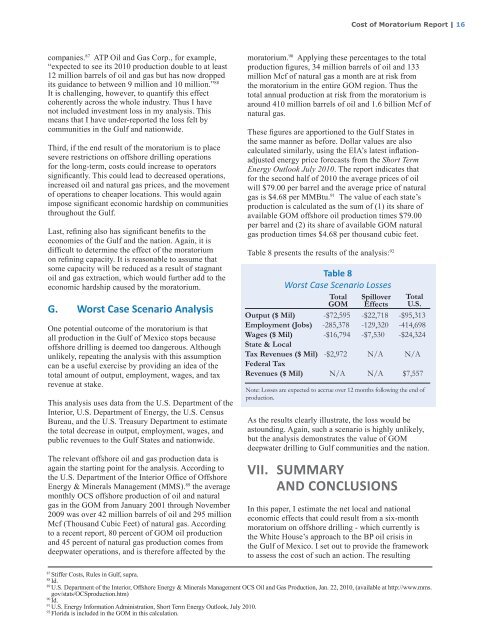The Economic Cost of a Moratorium on Offshore Oil and Gas ...
The Economic Cost of a Moratorium on Offshore Oil and Gas ...
The Economic Cost of a Moratorium on Offshore Oil and Gas ...
You also want an ePaper? Increase the reach of your titles
YUMPU automatically turns print PDFs into web optimized ePapers that Google loves.
<str<strong>on</strong>g>Cost</str<strong>on</strong>g> <str<strong>on</strong>g>of</str<strong>on</strong>g> <str<strong>on</strong>g>Moratorium</str<strong>on</strong>g> Report | 16<br />
companies. 87 ATP <strong>Oil</strong> <strong>and</strong> <strong>Gas</strong> Corp., for example,<br />
“expected to see its 2010 producti<strong>on</strong> double to at least<br />
12 milli<strong>on</strong> barrels <str<strong>on</strong>g>of</str<strong>on</strong>g> oil <strong>and</strong> gas but has now dropped<br />
its guidance to between 9 milli<strong>on</strong> <strong>and</strong> 10 milli<strong>on</strong>.” 88<br />
It is challenging, however, to quantify this effect<br />
coherently across the whole industry. Thus I have<br />
not included investment loss in my analysis. This<br />
means that I have under-reported the loss felt by<br />
communities in the Gulf <strong>and</strong> nati<strong>on</strong>wide.<br />
Third, if the end result <str<strong>on</strong>g>of</str<strong>on</strong>g> the moratorium is to place<br />
severe restricti<strong>on</strong>s <strong>on</strong> <str<strong>on</strong>g>of</str<strong>on</strong>g>fshore drilling operati<strong>on</strong>s<br />
for the l<strong>on</strong>g-term, costs could increase to operators<br />
significantly. This could lead to decreased operati<strong>on</strong>s,<br />
increased oil <strong>and</strong> natural gas prices, <strong>and</strong> the movement<br />
<str<strong>on</strong>g>of</str<strong>on</strong>g> operati<strong>on</strong>s to cheaper locati<strong>on</strong>s. This would again<br />
impose significant ec<strong>on</strong>omic hardship <strong>on</strong> communities<br />
throughout the Gulf.<br />
Last, refining also has significant benefits to the<br />
ec<strong>on</strong>omies <str<strong>on</strong>g>of</str<strong>on</strong>g> the Gulf <strong>and</strong> the nati<strong>on</strong>. Again, it is<br />
difficult to determine the effect <str<strong>on</strong>g>of</str<strong>on</strong>g> the moratorium<br />
<strong>on</strong> refining capacity. It is reas<strong>on</strong>able to assume that<br />
some capacity will be reduced as a result <str<strong>on</strong>g>of</str<strong>on</strong>g> stagnant<br />
oil <strong>and</strong> gas extracti<strong>on</strong>, which would further add to the<br />
ec<strong>on</strong>omic hardship caused by the moratorium.<br />
G. Worst Case Scenario Analysis<br />
One potential outcome <str<strong>on</strong>g>of</str<strong>on</strong>g> the moratorium is that<br />
all producti<strong>on</strong> in the Gulf <str<strong>on</strong>g>of</str<strong>on</strong>g> Mexico stops because<br />
<str<strong>on</strong>g>of</str<strong>on</strong>g>fshore drilling is deemed too dangerous. Although<br />
unlikely, repeating the analysis with this assumpti<strong>on</strong><br />
can be a useful exercise by providing an idea <str<strong>on</strong>g>of</str<strong>on</strong>g> the<br />
total amount <str<strong>on</strong>g>of</str<strong>on</strong>g> output, employment, wages, <strong>and</strong> tax<br />
revenue at stake.<br />
This analysis uses data from the U.S. Department <str<strong>on</strong>g>of</str<strong>on</strong>g> the<br />
Interior, U.S. Department <str<strong>on</strong>g>of</str<strong>on</strong>g> Energy, the U.S. Census<br />
Bureau, <strong>and</strong> the U.S. Treasury Department to estimate<br />
the total decrease in output, employment, wages, <strong>and</strong><br />
public revenues to the Gulf States <strong>and</strong> nati<strong>on</strong>wide.<br />
<str<strong>on</strong>g>The</str<strong>on</strong>g> relevant <str<strong>on</strong>g>of</str<strong>on</strong>g>fshore oil <strong>and</strong> gas producti<strong>on</strong> data is<br />
again the starting point for the analysis. According to<br />
the U.S. Department <str<strong>on</strong>g>of</str<strong>on</strong>g> the Interior Office <str<strong>on</strong>g>of</str<strong>on</strong>g> <strong>Offshore</strong><br />
Energy & Minerals Management (MMS). 89 the average<br />
m<strong>on</strong>thly OCS <str<strong>on</strong>g>of</str<strong>on</strong>g>fshore producti<strong>on</strong> <str<strong>on</strong>g>of</str<strong>on</strong>g> oil <strong>and</strong> natural<br />
gas in the GOM from January 2001 through November<br />
2009 was over 42 milli<strong>on</strong> barrels <str<strong>on</strong>g>of</str<strong>on</strong>g> oil <strong>and</strong> 295 milli<strong>on</strong><br />
Mcf (Thous<strong>and</strong> Cubic Feet) <str<strong>on</strong>g>of</str<strong>on</strong>g> natural gas. According<br />
to a recent report, 80 percent <str<strong>on</strong>g>of</str<strong>on</strong>g> GOM oil producti<strong>on</strong><br />
<strong>and</strong> 45 percent <str<strong>on</strong>g>of</str<strong>on</strong>g> natural gas producti<strong>on</strong> comes from<br />
deepwater operati<strong>on</strong>s, <strong>and</strong> is therefore affected by the<br />
moratorium. 90 Applying these percentages to the total<br />
producti<strong>on</strong> figures, 34 milli<strong>on</strong> barrels <str<strong>on</strong>g>of</str<strong>on</strong>g> oil <strong>and</strong> 133<br />
milli<strong>on</strong> Mcf <str<strong>on</strong>g>of</str<strong>on</strong>g> natural gas a m<strong>on</strong>th are at risk from<br />
the moratorium in the entire GOM regi<strong>on</strong>. Thus the<br />
total annual producti<strong>on</strong> at risk from the moratorium is<br />
around 410 milli<strong>on</strong> barrels <str<strong>on</strong>g>of</str<strong>on</strong>g> oil <strong>and</strong> 1.6 billi<strong>on</strong> Mcf <str<strong>on</strong>g>of</str<strong>on</strong>g><br />
natural gas.<br />
<str<strong>on</strong>g>The</str<strong>on</strong>g>se figures are apporti<strong>on</strong>ed to the Gulf States in<br />
the same manner as before. Dollar values are also<br />
calculated similarly, using the EIA’s latest inflati<strong>on</strong>adjusted<br />
energy price forecasts from the Short Term<br />
Energy Outlook July 2010. <str<strong>on</strong>g>The</str<strong>on</strong>g> report indicates that<br />
for the sec<strong>on</strong>d half <str<strong>on</strong>g>of</str<strong>on</strong>g> 2010 the average prices <str<strong>on</strong>g>of</str<strong>on</strong>g> oil<br />
will $79.00 per barrel <strong>and</strong> the average price <str<strong>on</strong>g>of</str<strong>on</strong>g> natural<br />
gas is $4.68 per MMBtu. 91 <str<strong>on</strong>g>The</str<strong>on</strong>g> value <str<strong>on</strong>g>of</str<strong>on</strong>g> each state’s<br />
producti<strong>on</strong> is calculated as the sum <str<strong>on</strong>g>of</str<strong>on</strong>g> (1) its share <str<strong>on</strong>g>of</str<strong>on</strong>g><br />
available GOM <str<strong>on</strong>g>of</str<strong>on</strong>g>fshore oil producti<strong>on</strong> times $79.00<br />
per barrel <strong>and</strong> (2) its share <str<strong>on</strong>g>of</str<strong>on</strong>g> available GOM natural<br />
gas producti<strong>on</strong> times $4.68 per thous<strong>and</strong> cubic feet.<br />
Table 8 presents the results <str<strong>on</strong>g>of</str<strong>on</strong>g> the analysis: 92<br />
Table 8<br />
Worst Case Scenario Losses<br />
Total<br />
GOM<br />
Spillover<br />
Effects<br />
Total<br />
U.S.<br />
Output ($ Mil) -$72,595 -$22,718 -$95,313<br />
Employment (Jobs) -285,378 -129,320 -414,698<br />
Wages ($ Mil) -$16,794 -$7,530 -$24,324<br />
State & Local<br />
Tax Revenues ($ Mil) -$2,972 N/A N/A<br />
Federal Tax<br />
Revenues ($ Mil) N/A N/A $7,557<br />
Note: Losses are expected to accrue over 12 m<strong>on</strong>ths following the end <str<strong>on</strong>g>of</str<strong>on</strong>g><br />
producti<strong>on</strong>.<br />
As the results clearly illustrate, the loss would be<br />
astounding. Again, such a scenario is highly unlikely,<br />
but the analysis dem<strong>on</strong>strates the value <str<strong>on</strong>g>of</str<strong>on</strong>g> GOM<br />
deepwater drilling to Gulf communities <strong>and</strong> the nati<strong>on</strong>.<br />
VII. SUMMARY<br />
AND CONCLUSIONS<br />
In this paper, I estimate the net local <strong>and</strong> nati<strong>on</strong>al<br />
ec<strong>on</strong>omic effects that could result from a six-m<strong>on</strong>th<br />
moratorium <strong>on</strong> <str<strong>on</strong>g>of</str<strong>on</strong>g>fshore drilling - which currently is<br />
the White House’s approach to the BP oil crisis in<br />
the Gulf <str<strong>on</strong>g>of</str<strong>on</strong>g> Mexico. I set out to provide the framework<br />
to assess the cost <str<strong>on</strong>g>of</str<strong>on</strong>g> such an acti<strong>on</strong>. <str<strong>on</strong>g>The</str<strong>on</strong>g> resulting<br />
87<br />
Stiffer <str<strong>on</strong>g>Cost</str<strong>on</strong>g>s, Rules in Gulf, supra.<br />
88<br />
Id.<br />
89 <br />
U.S. Department <str<strong>on</strong>g>of</str<strong>on</strong>g> the Interior, <strong>Offshore</strong> Energy & Minerals Management OCS <strong>Oil</strong> <strong>and</strong> <strong>Gas</strong> Producti<strong>on</strong>, Jan. 22, 2010, (available at http://www.mms.<br />
gov/stats/OCSproducti<strong>on</strong>.htm)<br />
90<br />
Id.<br />
91<br />
U.S. Energy Informati<strong>on</strong> Administrati<strong>on</strong>, Short Term Energy Outlook, July 2010.<br />
92<br />
Florida is included in the GOM in this calculati<strong>on</strong>.


